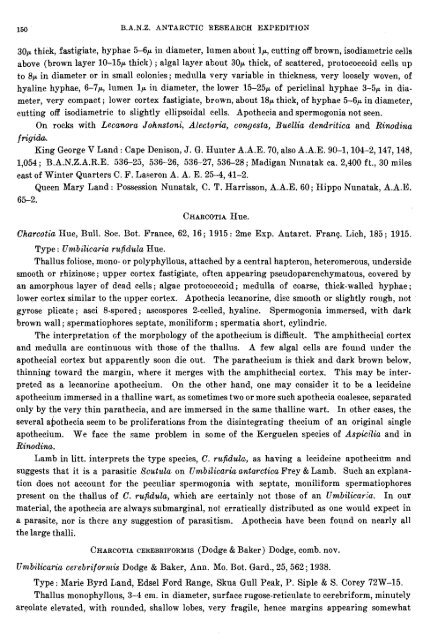You also want an ePaper? Increase the reach of your titles
YUMPU automatically turns print PDFs into web optimized ePapers that Google loves.
150 B.A.N.Z. ANTARCTIC HESEAItCH EXPEDITlON<br />
30p thick, fastigiate, hyphae 5-6p in diameter, lumen abont lp, cutting off brown, isodianletric cells<br />
above (brown layer 10-15p thiclr) ; algal layer about 30p thick, of scattered, protococcoid cells up<br />
to 8p in diameter or in small colonies; medulla very variable in thickness, very loosely woven, of<br />
hyaline hyphae, 6-7p, lnmen lp in diameter, the lower 15-25p of periclinal hyphae 3-Sp in dia-<br />
meter, very compact ; lower cortex fastigiate, brown, about 18p thick, of hyphae 5-6p in diameter,<br />
cutting off isodiametric to slightly ellipsoidal cells. Apothecia and spermogoilia not seen.<br />
On rocks with Lecanora Johnstoni, Alectoria, congesta, Buellia dendritica and Rinodilla<br />
f rigida.<br />
King George V Land: Cape Denison, J. G. IIuiiter A.A.E. 70, also A.A.E. 90-1,104-2,147,148,<br />
1,054 ; B.A.N.Z.A.R.E. 536-26, 536-26, 536-27, 536-28 ; Madigan Nnnatalr ca. 2,400 f t., 30 miles<br />
east of Winter Quarters C. F. Laseron A. A. E. 254,41-2.<br />
Queen Mary Land : Possession Nunatalr, C. T. Harrisson, A.A.E. 60 ; Hippo Nunatak, A.A.E.<br />
65-2.<br />
CHARCOTIA Hue.<br />
Charcotia Hue, Bull. Soc. Bot. France, 62, 16; 1915: 2me Exp. Antarct. Frang. Lich, 185; 1915.<br />
Type : Unzbilicaria rufidula Hue.<br />
Thallus foliose, mono- or polyphyllous, attached by a central hapteron, heteromerous, underside<br />
smooth or rhizinose; upper cortex fastigiate, often appearing pseudoparenchymatous, covered by<br />
an amorphous layer of dead cells ; algae protococcoid ; medulla of coarse, thick-walled hyphae ;<br />
lower cortex similar to the upper cortex. Apothecia lecanorine, disc smooth or slightly rongh, not<br />
gyrose plicate ; asci 8-spored ; ascospores 2-celled, hyaline. Spermogonia immersed, with dark<br />
brown wall; spermatiophores septate, moniliform; spermatia short, cylindric.<br />
The interpretation cf the morphology of the apothecium is difficult. The amphithecial cortex<br />
and medulla are continuous with those of the thallns. A few algal cells are found under the<br />
apothecial cortex but apparently soon die out. The parathecium is thick and dark brown below,<br />
thinning toward the margin, where it merges with the amphithecial cortex. This may be interpreted<br />
as a lecanoriile apothecium. On the other hand, one may consider it to be a leddeiile<br />
apothecinm immersed in a thalline wart, as sometimes two or more such apothecia coalesce, separated<br />
only by the very thin parathecia, and are immersed in the same thalline wart. In other cases, the<br />
several abothecia seem to be proliferations from the disintegrating thecium of an original single<br />
apothecium. We face the same problem in some of the Kerguekn species of Aspicilia and in<br />
Rinodina.<br />
Lamb in litt. interprets the type species, C. rz~fiduk,, as having a lecideine apotheci~nn and<br />
suggets that it is a parasitic Xcutula on Tlntbilica~ia antalrctica Frey &Lamb. Such an explanation<br />
does not account for the pecnliar spermogonia with septate, moniliform spermatiophores<br />
present on the thallus of C. rufidula, which are certainly not those of an Untbilicar;~. In our<br />
material, the apothecia are always submarginal, not erratically distributed as one would expect in<br />
a parasite, nor is there any suggestion of parasitism. Apothecia have been found on nearly all<br />
the large thalli.<br />
CHARCOTIA CEREBRIFORMIS (Dodge & Baker) Dodge, comb. nov.<br />
Um.bilicaria cerebrifornlis Dodge & Balrer, Ann. Mo. Bot. Card., 25, 562; 1938.<br />
Type : Marie Byrd Land, Edsel Ford Range, Skua Gull Peak, P. Siple & S. Corey 72W-15.<br />
Thallus monophyllous, 34 cm. in diameter, surface rugose-reticulate to cerebriform, minutely<br />
areolate elevated, with rounded, shallow lobes, very fragile, hence margins appearing somewhat

















